

Compact Muon Solenoid
LHC, CERN
| CMS-PAS-BPH-22-005 | ||
| Test of lepton flavor universality in B±→K±ℓ+ℓ− decays | ||
| CMS Collaboration | ||
| 31 August 2023 | ||
| Abstract: A test of lepton flavor universality in B±→K±ℓ+ℓ− decays, where ℓ is a muon or electron, as well as a measurement of differential and inclusive branching fractions of a nonresonant B±→K±μ+μ− decay with the CMS experiment at the LHC are presented. The analysis is made possible by a dedicated data set of proton-proton collisions at √s= 13 TeV recorded in 2018, using a special high-rate data stream designed for collecting about 10 billion unbiased b hadron decays. The ratio of the branching fractions B(B±→K±μ+μ−) to B(B±→K±e+e−) is measured as a double ratio R(K) of these decays to the respective branching fractions of the B±→J/ψK± (J/ψ→μ+μ−) and (J/ψ→e+e−) decays, which allow for significant cancellation of systematic uncertainties. The ratio R(K) is measured in a range 1.1 <q2< 6.0 GeV2, where q is the invariant mass of the lepton pair, and is found to be R(K)= 0.78 +0.47−0.23, in agreement with the standard model expectation within one standard deviation. This measurement is limited by the statistical precision of the electron channel. The inclusive branching fraction in the same q2 range of B(B±→K±μ+μ−)= ( 12.42 ± 0.68 ) × 10−8 is consistent with and has a comparable precision to the present world average value. | ||
|
Links:
CDS record (PDF) ;
CADI line (restricted) ;
These preliminary results are superseded in this paper, Submitted to ROPP. The superseded preliminary plots can be found here. |
||
| Figures | |

png pdf |
Figure 1:
Representative Feynman diagrams for the decay of a B+ meson into a K+ meson and a lepton pair for the SM (left) and for a BSM scenario introducing a leptoquark (LQ) with flavor-dependent couplings (right). |
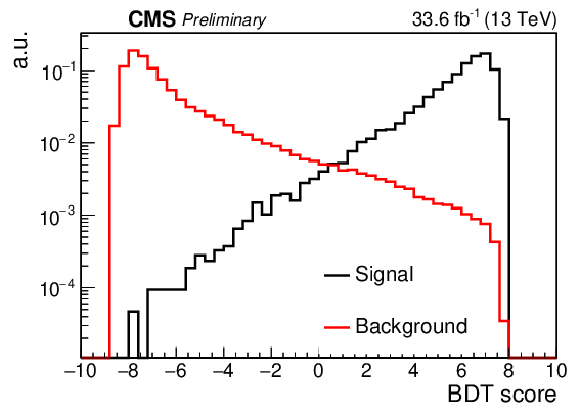
png pdf |
Figure 2:
Analysis BDT score for signal (MC simulation in red) and background (same-sign dimuon data in black) for the muon channel. |
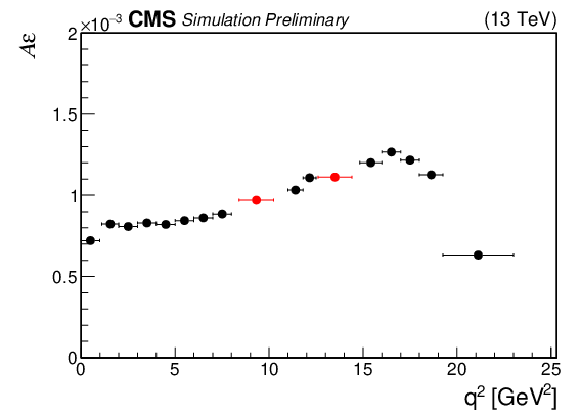
png pdf |
Figure 3:
The product of acceptance and efficiency (Aϵ) as a function of the muon pair q2, as measured in simulated signal events, corrected to match data. Regions corresponding to resonances are displayed with red markers. |
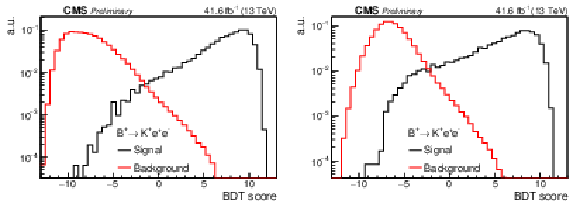
png pdf |
Figure 4:
Analysis BDT score for signal (MC simulation in red) and background (same-sign dielectron data in black) for the electron channel for PF-PF (left) and PF-LP (right) categories. |
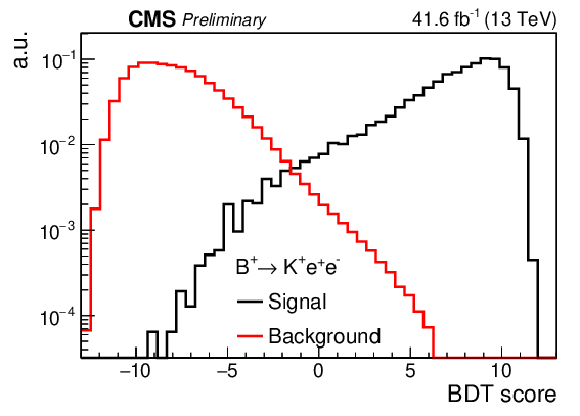
png pdf |
Figure 4-a:
Analysis BDT score for signal (MC simulation in red) and background (same-sign dielectron data in black) for the electron channel for PF-PF (left) and PF-LP (right) categories. |
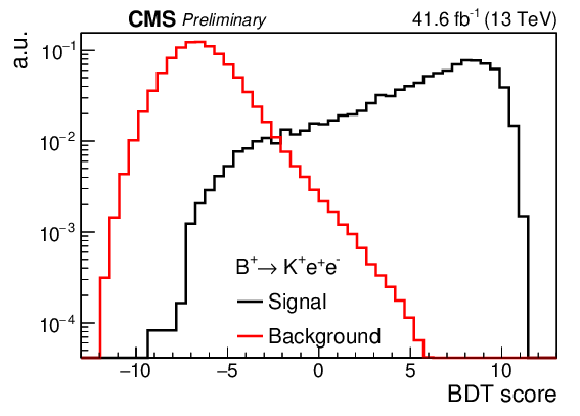
png pdf |
Figure 4-b:
Analysis BDT score for signal (MC simulation in red) and background (same-sign dielectron data in black) for the electron channel for PF-PF (left) and PF-LP (right) categories. |
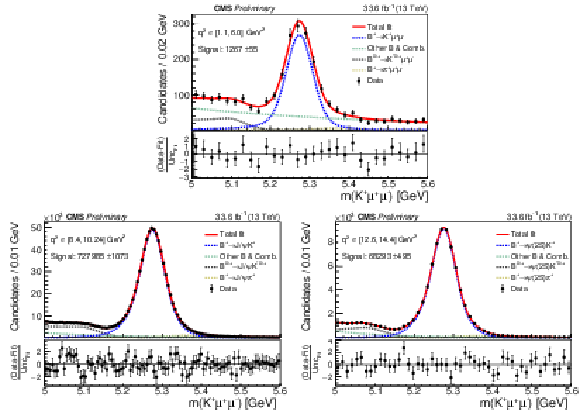
png pdf |
Figure 5:
Results of unbinned likelihood fits to the invariant mass distributions in the (upper row) low-q2 signal region and in the (lower row) B+→J/ψ(μ+μ−)K+ (left) and B+→ψ(2S)(μ+μ−)K+ (right) control regions. The lower panels show the distribution of the pull, which is defined as the difference between the data and the fit, divided by the fit uncertainty. |
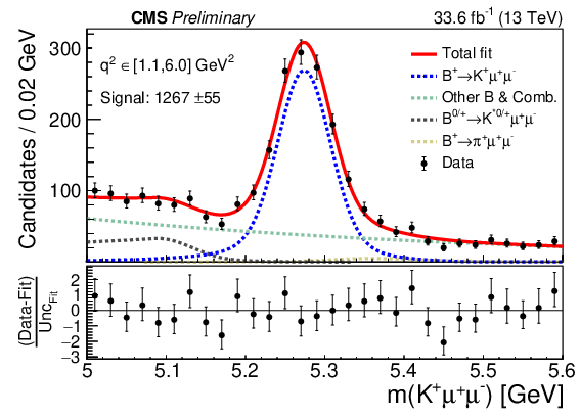
png pdf |
Figure 5-a:
Results of unbinned likelihood fits to the invariant mass distributions in the (upper row) low-q2 signal region and in the (lower row) B+→J/ψ(μ+μ−)K+ (left) and B+→ψ(2S)(μ+μ−)K+ (right) control regions. The lower panels show the distribution of the pull, which is defined as the difference between the data and the fit, divided by the fit uncertainty. |
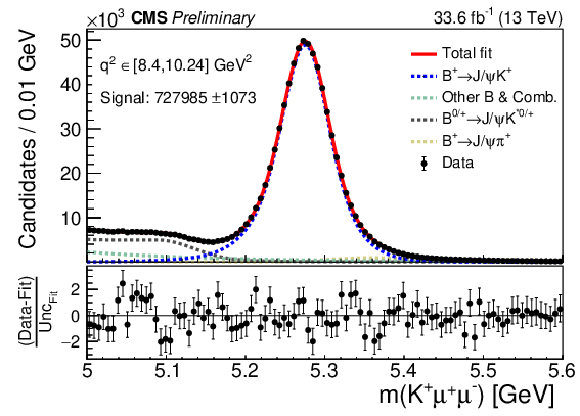
png pdf |
Figure 5-b:
Results of unbinned likelihood fits to the invariant mass distributions in the (upper row) low-q2 signal region and in the (lower row) B+→J/ψ(μ+μ−)K+ (left) and B+→ψ(2S)(μ+μ−)K+ (right) control regions. The lower panels show the distribution of the pull, which is defined as the difference between the data and the fit, divided by the fit uncertainty. |
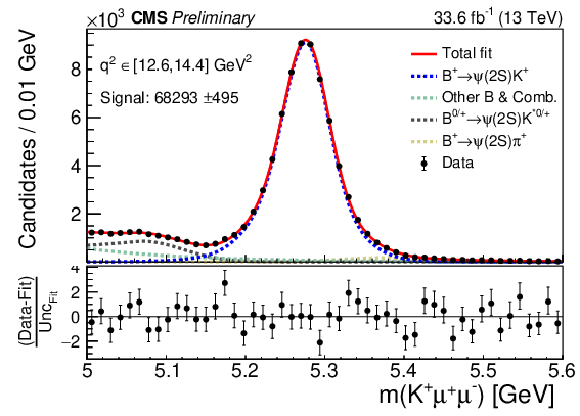
png pdf |
Figure 5-c:
Results of unbinned likelihood fits to the invariant mass distributions in the (upper row) low-q2 signal region and in the (lower row) B+→J/ψ(μ+μ−)K+ (left) and B+→ψ(2S)(μ+μ−)K+ (right) control regions. The lower panels show the distribution of the pull, which is defined as the difference between the data and the fit, divided by the fit uncertainty. |

png pdf |
Figure 6:
The K+μ+μ− invariant mass distributions in various q2 bins, with the result of the simultaneous fit overlaid in blue and the individual fit components as described in the legends for (from upper left to lower right): [0,0.98], [1.1,2.0], [2.0,3.0][3.0,4.0], [4.0,5.0], [5.0,6.0], [6.0,7.0], and [7.0,8.0], q2 bins. The lower panels show the distribution of the pull, which is defined as the difference between the data and the fit, divided by the fit uncertainty. |
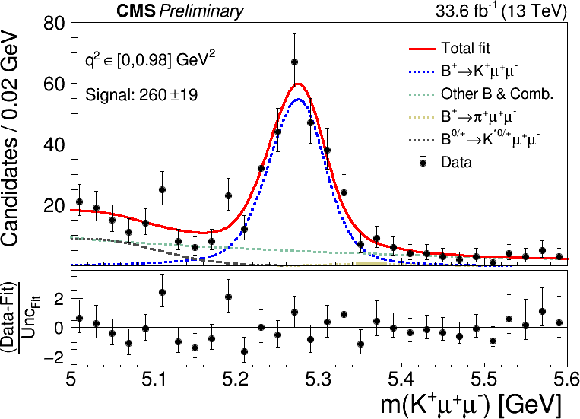
png |
Figure 6-a:
The K+μ+μ− invariant mass distributions in various q2 bins, with the result of the simultaneous fit overlaid in blue and the individual fit components as described in the legends for (from upper left to lower right): [0,0.98], [1.1,2.0], [2.0,3.0][3.0,4.0], [4.0,5.0], [5.0,6.0], [6.0,7.0], and [7.0,8.0], q2 bins. The lower panels show the distribution of the pull, which is defined as the difference between the data and the fit, divided by the fit uncertainty. |
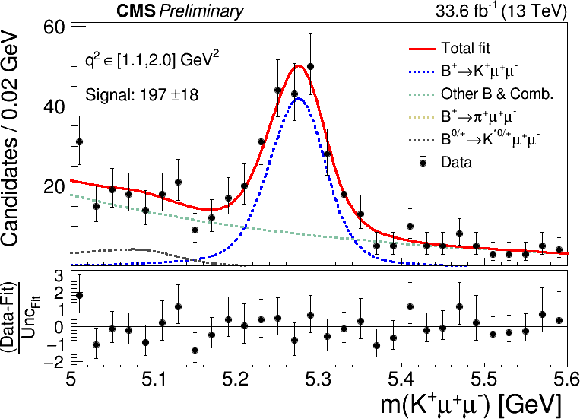
png |
Figure 6-b:
The K+μ+μ− invariant mass distributions in various q2 bins, with the result of the simultaneous fit overlaid in blue and the individual fit components as described in the legends for (from upper left to lower right): [0,0.98], [1.1,2.0], [2.0,3.0][3.0,4.0], [4.0,5.0], [5.0,6.0], [6.0,7.0], and [7.0,8.0], q2 bins. The lower panels show the distribution of the pull, which is defined as the difference between the data and the fit, divided by the fit uncertainty. |
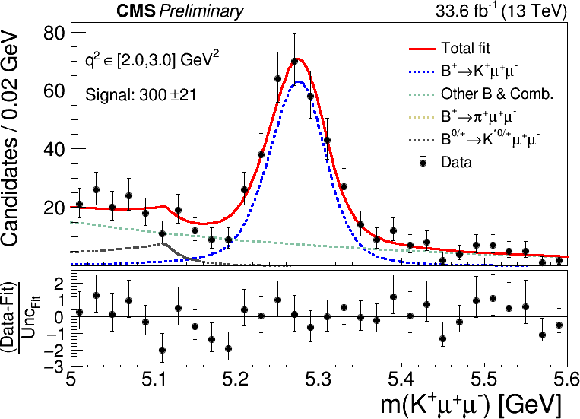
png |
Figure 6-c:
The K+μ+μ− invariant mass distributions in various q2 bins, with the result of the simultaneous fit overlaid in blue and the individual fit components as described in the legends for (from upper left to lower right): [0,0.98], [1.1,2.0], [2.0,3.0][3.0,4.0], [4.0,5.0], [5.0,6.0], [6.0,7.0], and [7.0,8.0], q2 bins. The lower panels show the distribution of the pull, which is defined as the difference between the data and the fit, divided by the fit uncertainty. |
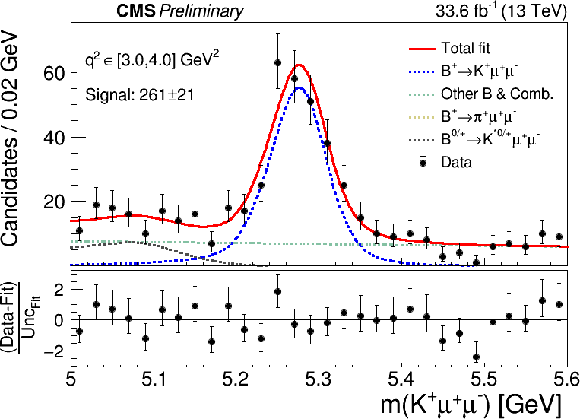
png |
Figure 6-d:
The K+μ+μ− invariant mass distributions in various q2 bins, with the result of the simultaneous fit overlaid in blue and the individual fit components as described in the legends for (from upper left to lower right): [0,0.98], [1.1,2.0], [2.0,3.0][3.0,4.0], [4.0,5.0], [5.0,6.0], [6.0,7.0], and [7.0,8.0], q2 bins. The lower panels show the distribution of the pull, which is defined as the difference between the data and the fit, divided by the fit uncertainty. |
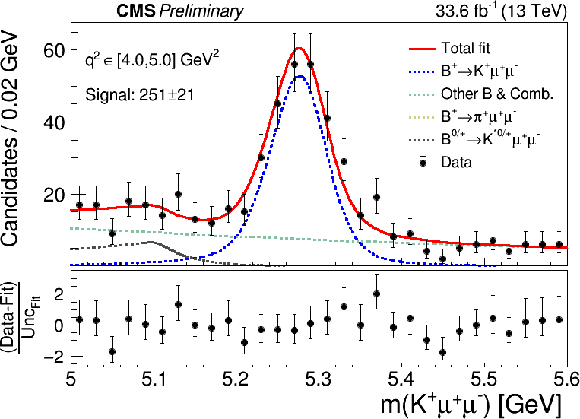
png |
Figure 6-e:
The K+μ+μ− invariant mass distributions in various q2 bins, with the result of the simultaneous fit overlaid in blue and the individual fit components as described in the legends for (from upper left to lower right): [0,0.98], [1.1,2.0], [2.0,3.0][3.0,4.0], [4.0,5.0], [5.0,6.0], [6.0,7.0], and [7.0,8.0], q2 bins. The lower panels show the distribution of the pull, which is defined as the difference between the data and the fit, divided by the fit uncertainty. |
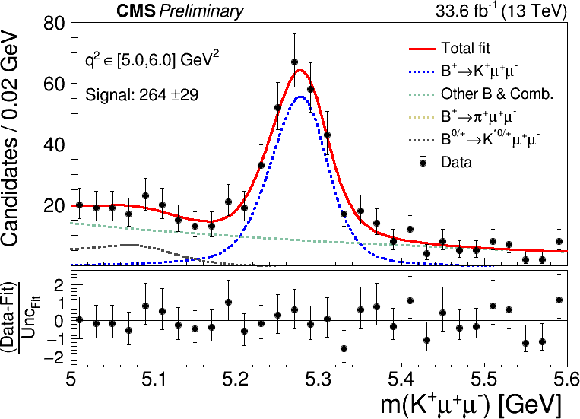
png |
Figure 6-f:
The K+μ+μ− invariant mass distributions in various q2 bins, with the result of the simultaneous fit overlaid in blue and the individual fit components as described in the legends for (from upper left to lower right): [0,0.98], [1.1,2.0], [2.0,3.0][3.0,4.0], [4.0,5.0], [5.0,6.0], [6.0,7.0], and [7.0,8.0], q2 bins. The lower panels show the distribution of the pull, which is defined as the difference between the data and the fit, divided by the fit uncertainty. |
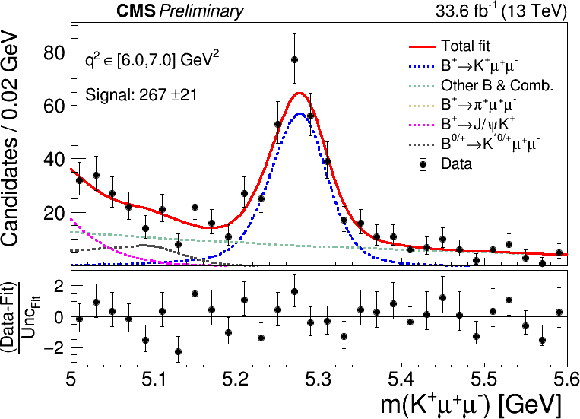
png |
Figure 6-g:
The K+μ+μ− invariant mass distributions in various q2 bins, with the result of the simultaneous fit overlaid in blue and the individual fit components as described in the legends for (from upper left to lower right): [0,0.98], [1.1,2.0], [2.0,3.0][3.0,4.0], [4.0,5.0], [5.0,6.0], [6.0,7.0], and [7.0,8.0], q2 bins. The lower panels show the distribution of the pull, which is defined as the difference between the data and the fit, divided by the fit uncertainty. |
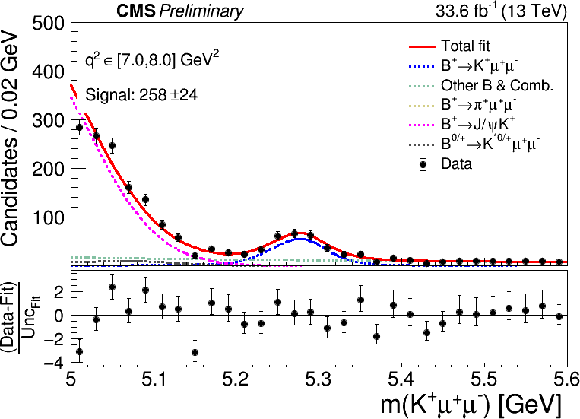
png |
Figure 6-h:
The K+μ+μ− invariant mass distributions in various q2 bins, with the result of the simultaneous fit overlaid in blue and the individual fit components as described in the legends for (from upper left to lower right): [0,0.98], [1.1,2.0], [2.0,3.0][3.0,4.0], [4.0,5.0], [5.0,6.0], [6.0,7.0], and [7.0,8.0], q2 bins. The lower panels show the distribution of the pull, which is defined as the difference between the data and the fit, divided by the fit uncertainty. |
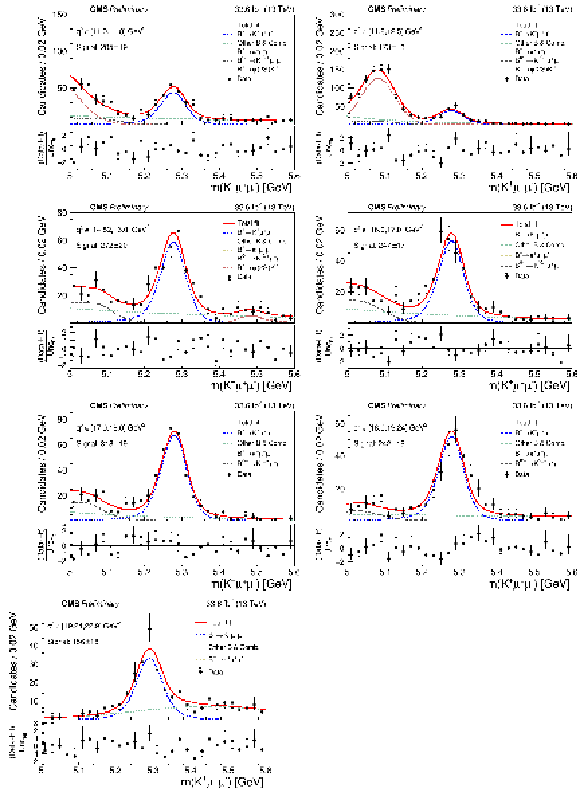
png pdf |
Figure 7:
The K+μ+μ− invariant mass distributions in various q2 bins, with the result of the simultaneous fit overlaid in blue and the individual fit components as described in the legends for (from upper left to lower right): [11.0,11.8], [11.8,12.5], [14.82,16.0], [16.0,17.0], [17.0,18.0], [18.0,19.24], and [19.24,22.9] GeV2 q2 bins. The lower panels show the distribution of the pull, which is defined as the difference between the data and the fit, divided by the fit uncertainty. |
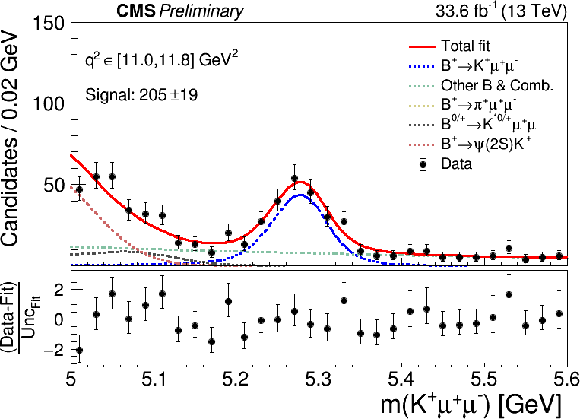
png |
Figure 7-a:
The K+μ+μ− invariant mass distributions in various q2 bins, with the result of the simultaneous fit overlaid in blue and the individual fit components as described in the legends for (from upper left to lower right): [11.0,11.8], [11.8,12.5], [14.82,16.0], [16.0,17.0], [17.0,18.0], [18.0,19.24], and [19.24,22.9] GeV2 q2 bins. The lower panels show the distribution of the pull, which is defined as the difference between the data and the fit, divided by the fit uncertainty. |
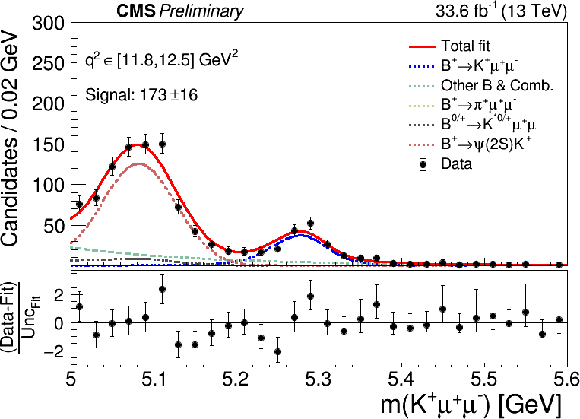
png |
Figure 7-b:
The K+μ+μ− invariant mass distributions in various q2 bins, with the result of the simultaneous fit overlaid in blue and the individual fit components as described in the legends for (from upper left to lower right): [11.0,11.8], [11.8,12.5], [14.82,16.0], [16.0,17.0], [17.0,18.0], [18.0,19.24], and [19.24,22.9] GeV2 q2 bins. The lower panels show the distribution of the pull, which is defined as the difference between the data and the fit, divided by the fit uncertainty. |
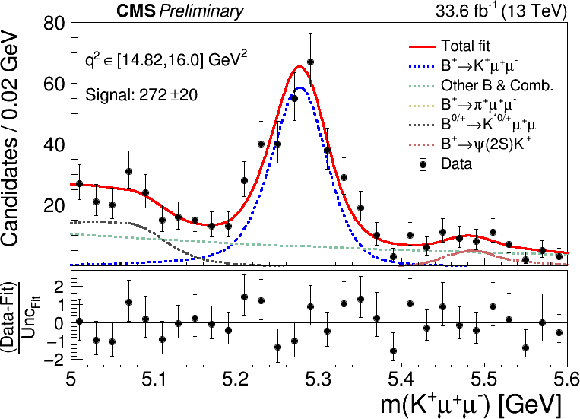
png |
Figure 7-c:
The K+μ+μ− invariant mass distributions in various q2 bins, with the result of the simultaneous fit overlaid in blue and the individual fit components as described in the legends for (from upper left to lower right): [11.0,11.8], [11.8,12.5], [14.82,16.0], [16.0,17.0], [17.0,18.0], [18.0,19.24], and [19.24,22.9] GeV2 q2 bins. The lower panels show the distribution of the pull, which is defined as the difference between the data and the fit, divided by the fit uncertainty. |
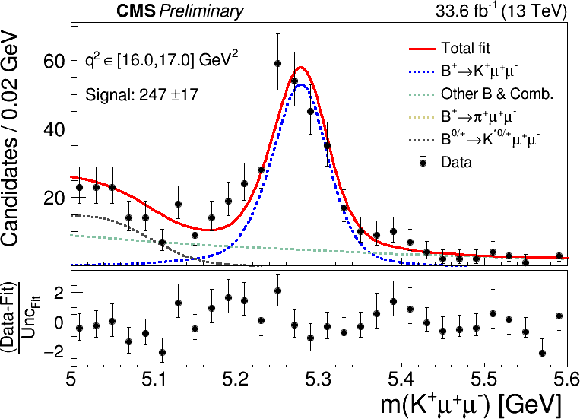
png |
Figure 7-d:
The K+μ+μ− invariant mass distributions in various q2 bins, with the result of the simultaneous fit overlaid in blue and the individual fit components as described in the legends for (from upper left to lower right): [11.0,11.8], [11.8,12.5], [14.82,16.0], [16.0,17.0], [17.0,18.0], [18.0,19.24], and [19.24,22.9] GeV2 q2 bins. The lower panels show the distribution of the pull, which is defined as the difference between the data and the fit, divided by the fit uncertainty. |
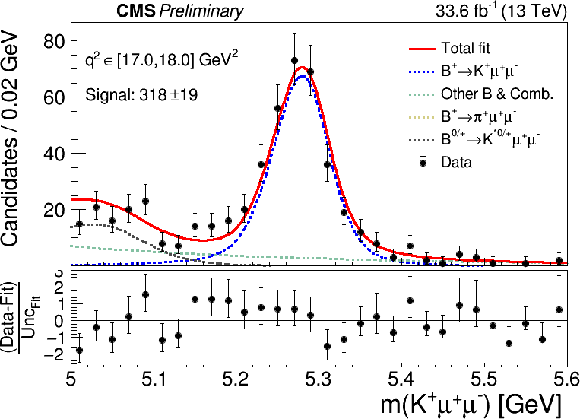
png |
Figure 7-e:
The K+μ+μ− invariant mass distributions in various q2 bins, with the result of the simultaneous fit overlaid in blue and the individual fit components as described in the legends for (from upper left to lower right): [11.0,11.8], [11.8,12.5], [14.82,16.0], [16.0,17.0], [17.0,18.0], [18.0,19.24], and [19.24,22.9] GeV2 q2 bins. The lower panels show the distribution of the pull, which is defined as the difference between the data and the fit, divided by the fit uncertainty. |
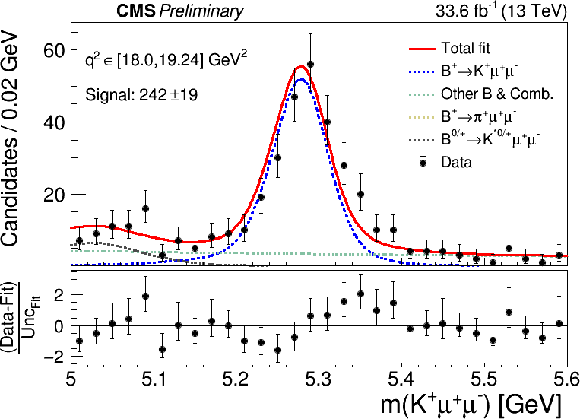
png |
Figure 7-f:
The K+μ+μ− invariant mass distributions in various q2 bins, with the result of the simultaneous fit overlaid in blue and the individual fit components as described in the legends for (from upper left to lower right): [11.0,11.8], [11.8,12.5], [14.82,16.0], [16.0,17.0], [17.0,18.0], [18.0,19.24], and [19.24,22.9] GeV2 q2 bins. The lower panels show the distribution of the pull, which is defined as the difference between the data and the fit, divided by the fit uncertainty. |
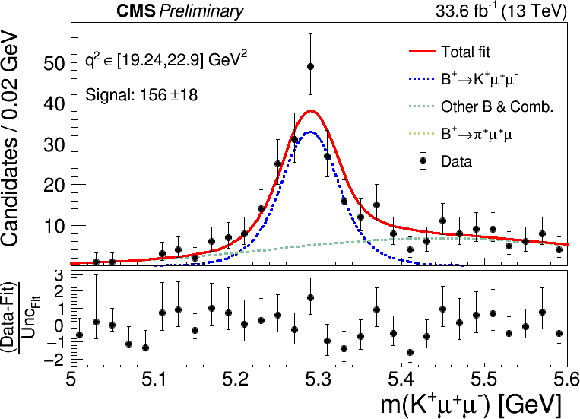
png |
Figure 7-g:
The K+μ+μ− invariant mass distributions in various q2 bins, with the result of the simultaneous fit overlaid in blue and the individual fit components as described in the legends for (from upper left to lower right): [11.0,11.8], [11.8,12.5], [14.82,16.0], [16.0,17.0], [17.0,18.0], [18.0,19.24], and [19.24,22.9] GeV2 q2 bins. The lower panels show the distribution of the pull, which is defined as the difference between the data and the fit, divided by the fit uncertainty. |
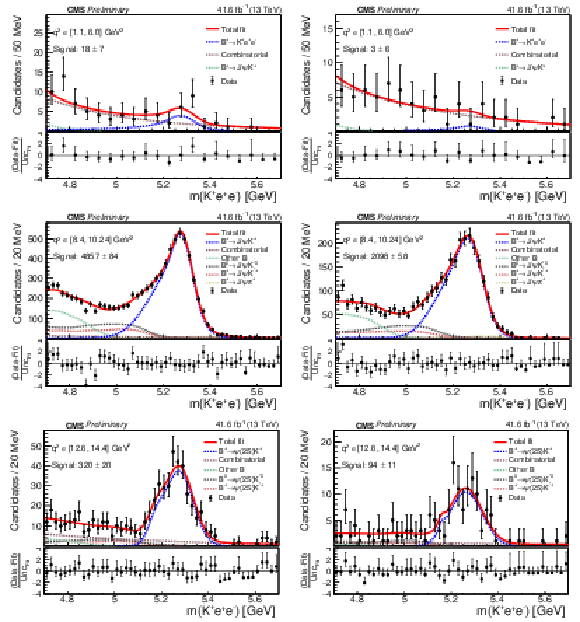
png pdf |
Figure 8:
The K+e+e− mass spectrum with the results of the fit show with the red line in the low-q2 region (upper row), B+→J/ψ(e+e−)K+ control region (middle row), and B+→ψ(2S)(e+e−)K+ control region (lower row) for the PF-PF (left) and PF-LP (right) categories. The shoulder below the nominal B+ meson mass for the ψ(2S) control region is due to the narrow q2 range in this bin. The lower panels show the distribution of the pull, which is defined as the difference between the data and the fit, divided by their combined uncertainty. |
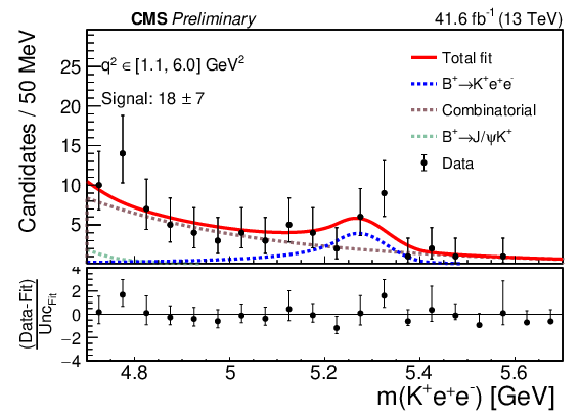
png pdf |
Figure 8-a:
The K+e+e− mass spectrum with the results of the fit show with the red line in the low-q2 region (upper row), B+→J/ψ(e+e−)K+ control region (middle row), and B+→ψ(2S)(e+e−)K+ control region (lower row) for the PF-PF (left) and PF-LP (right) categories. The shoulder below the nominal B+ meson mass for the ψ(2S) control region is due to the narrow q2 range in this bin. The lower panels show the distribution of the pull, which is defined as the difference between the data and the fit, divided by their combined uncertainty. |
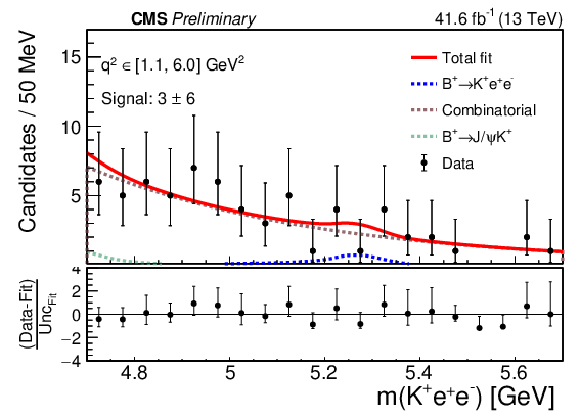
png pdf |
Figure 8-b:
The K+e+e− mass spectrum with the results of the fit show with the red line in the low-q2 region (upper row), B+→J/ψ(e+e−)K+ control region (middle row), and B+→ψ(2S)(e+e−)K+ control region (lower row) for the PF-PF (left) and PF-LP (right) categories. The shoulder below the nominal B+ meson mass for the ψ(2S) control region is due to the narrow q2 range in this bin. The lower panels show the distribution of the pull, which is defined as the difference between the data and the fit, divided by their combined uncertainty. |
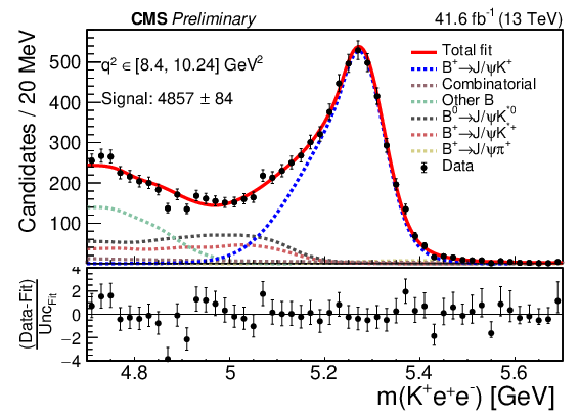
png pdf |
Figure 8-c:
The K+e+e− mass spectrum with the results of the fit show with the red line in the low-q2 region (upper row), B+→J/ψ(e+e−)K+ control region (middle row), and B+→ψ(2S)(e+e−)K+ control region (lower row) for the PF-PF (left) and PF-LP (right) categories. The shoulder below the nominal B+ meson mass for the ψ(2S) control region is due to the narrow q2 range in this bin. The lower panels show the distribution of the pull, which is defined as the difference between the data and the fit, divided by their combined uncertainty. |
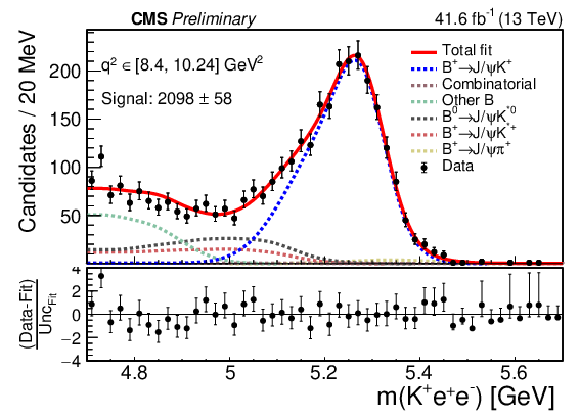
png pdf |
Figure 8-d:
The K+e+e− mass spectrum with the results of the fit show with the red line in the low-q2 region (upper row), B+→J/ψ(e+e−)K+ control region (middle row), and B+→ψ(2S)(e+e−)K+ control region (lower row) for the PF-PF (left) and PF-LP (right) categories. The shoulder below the nominal B+ meson mass for the ψ(2S) control region is due to the narrow q2 range in this bin. The lower panels show the distribution of the pull, which is defined as the difference between the data and the fit, divided by their combined uncertainty. |
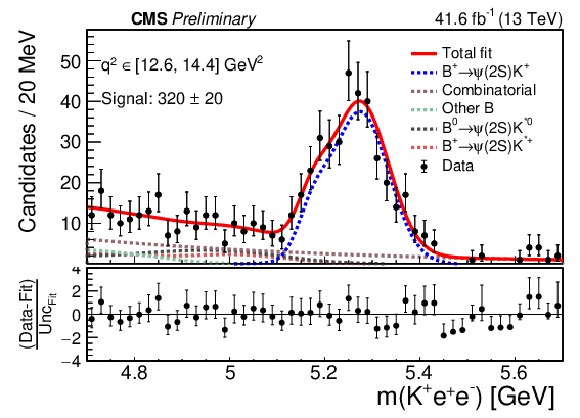
png pdf |
Figure 8-e:
The K+e+e− mass spectrum with the results of the fit show with the red line in the low-q2 region (upper row), B+→J/ψ(e+e−)K+ control region (middle row), and B+→ψ(2S)(e+e−)K+ control region (lower row) for the PF-PF (left) and PF-LP (right) categories. The shoulder below the nominal B+ meson mass for the ψ(2S) control region is due to the narrow q2 range in this bin. The lower panels show the distribution of the pull, which is defined as the difference between the data and the fit, divided by their combined uncertainty. |
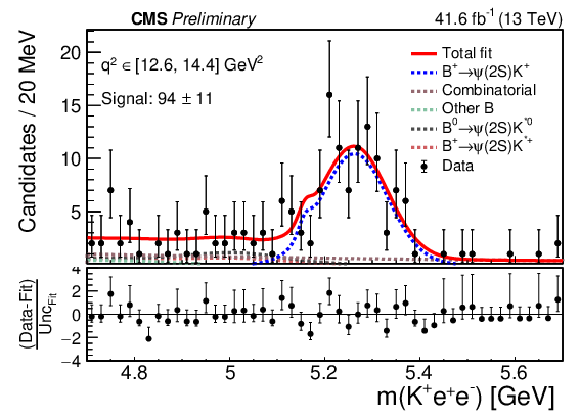
png pdf |
Figure 8-f:
The K+e+e− mass spectrum with the results of the fit show with the red line in the low-q2 region (upper row), B+→J/ψ(e+e−)K+ control region (middle row), and B+→ψ(2S)(e+e−)K+ control region (lower row) for the PF-PF (left) and PF-LP (right) categories. The shoulder below the nominal B+ meson mass for the ψ(2S) control region is due to the narrow q2 range in this bin. The lower panels show the distribution of the pull, which is defined as the difference between the data and the fit, divided by their combined uncertainty. |
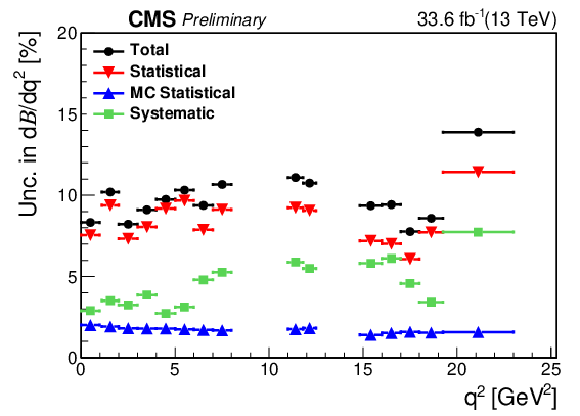
png pdf |
Figure 9:
Relative uncertainties in the differential branching fraction per q2 bin. Different colors correspond to statistical, simulation statistical, and systematic uncertainties. |
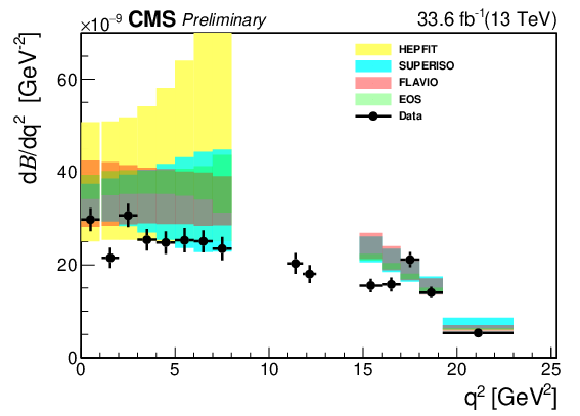
png pdf |
Figure 10:
Comparison of the measured differential B+→K+μ+μ− branching fraction with the theoretical predictions obtained using FLAVIO, SUPERISO, HEPFIT, and EOS packages. |
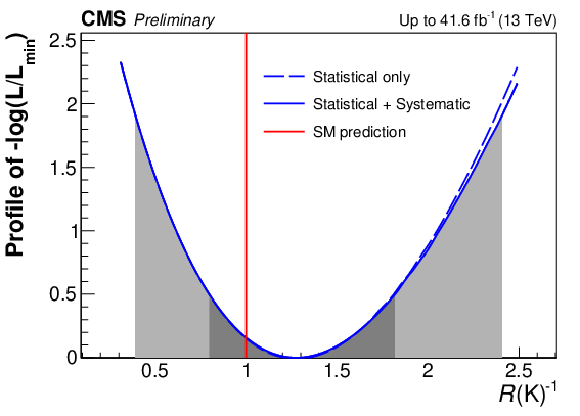
png pdf |
Figure 11:
Likelihood function from the fit profiled as a function of R(K)−1. |
| Tables | |

png pdf |
Table 1:
Summary of the loosest muon trigger requirements imposed by the L1 and HLT algorithms for each instantaneous luminosity scenario: the L1 and HLT muon transverse momentum thresholds pμT, and the HLT muon impact parameter significance IPsig, defined as the impact parameter in the plane perpendicular to the beams divided by its uncertainty. Also shown are the trigger purity and peak HLT rate. All values are shown in bins of the peak instantaneous luminosity L. |
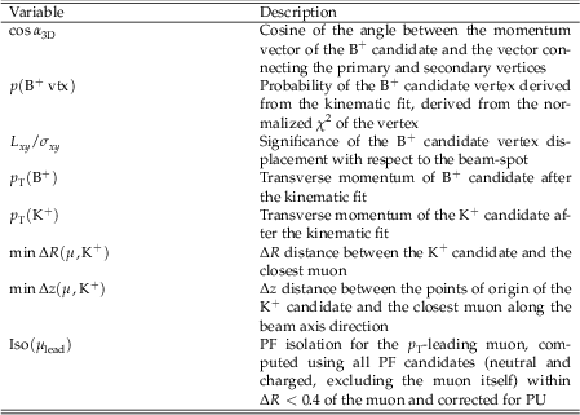
png pdf |
Table 2:
Input variables used in the muon channel BDT. |

png pdf |
Table 3:
The product of acceptance and efficiency (Aϵ) for the muon channel for the signal in the low-q2 bin and for the B+→J/ψ(μ+μ−)K+ control sample. |
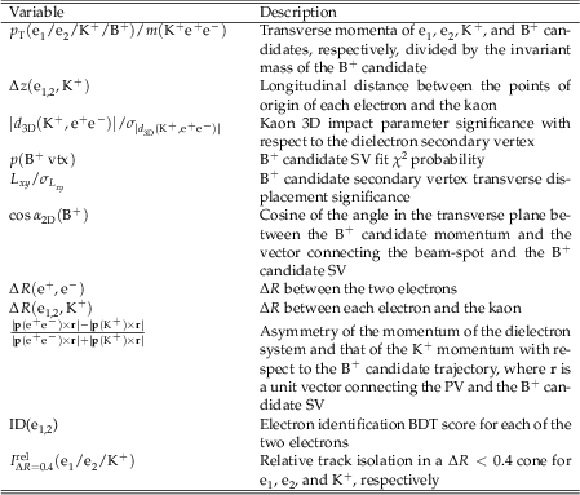
png pdf |
Table 4:
Input variables used in the electron channel BDTs, for both PF-PF and PF-LP categories. |

png pdf |
Table 5:
The product of acceptance and efficiency (Aϵ) for the electron channel for the signal in the low-q2 bin, and for the B+→J/ψ(e+e−)K+ and B+→ψ(2S)(e+e−)K+ control regions in the PF-PF and PF-LP categories. Trigger efficiency is not included in the quoted numbers, and they represent the average across the corresponding q2 bin. |

png pdf |
Table 6:
Fit functions used for signal and background sources in each q2 bin. The ``--" symbol indicates that the corresponding background does not apply in this channel. |

png pdf |
Table 7:
Event yields in the muon channel. |
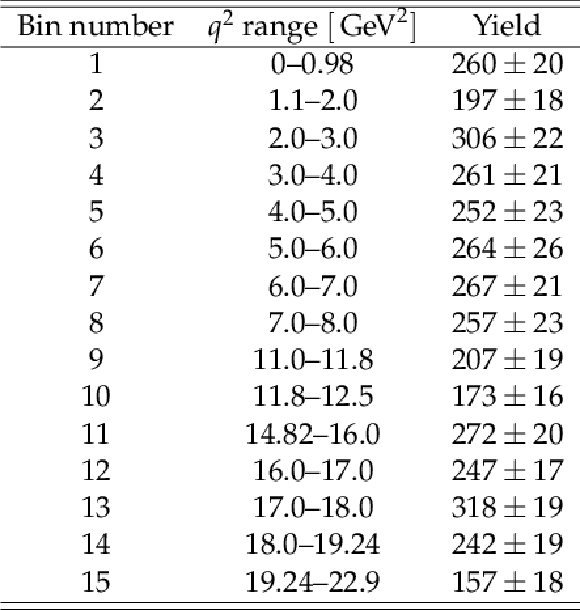
png pdf |
Table 8:
Yields per q2 bin extracted from the simultaneous fit in the B+→K+μ+μ− channel. The uncertainties shown are statistical uncertainties from the fit. |

png pdf |
Table 9:
Fit functions used to describe signal and various background components for the electron channel. The ``--'' sign implies that the specific source of the background is not relevant in this region. |

png pdf |
Table 10:
Signal yields in the electron channel in the low-q2 bin and resonant CRs, for both PF-PF and PF-LP categories. |
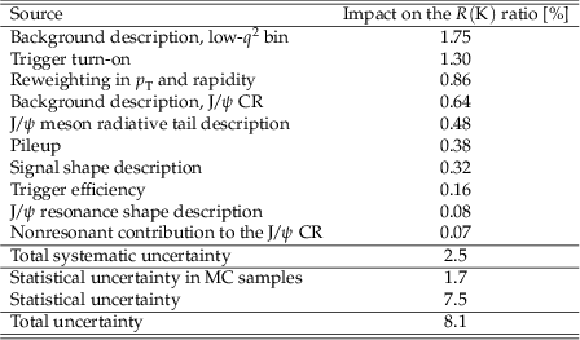
png pdf |
Table 11:
Major sources of uncertainty in the B+→K+μ+μ−/B+→J/ψ(μ+μ−)K+ ratio measurement. |
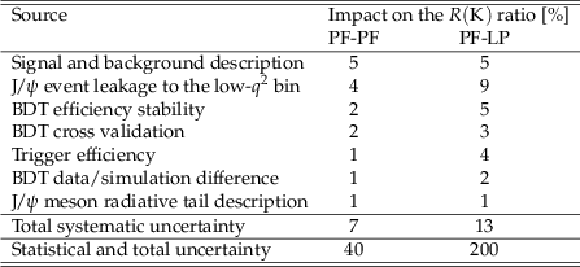
png pdf |
Table 12:
Major sources of uncertainty in the B+→K+e+e−/B+→J/ψ(e+e−)K+ ratio measurement in the PF-PF and PF-LP categories. The last row shows the statistical uncertainty, which is the same as the total uncertainty within the quoted precision. |
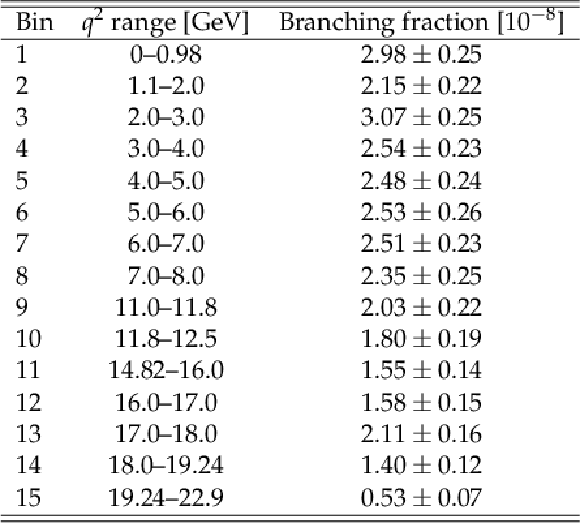
png pdf |
Table 13:
The differential B+→K+μ+μ− branching fraction measured in the individual q2 bins. The uncertainties include both the statistical and systematic components. |
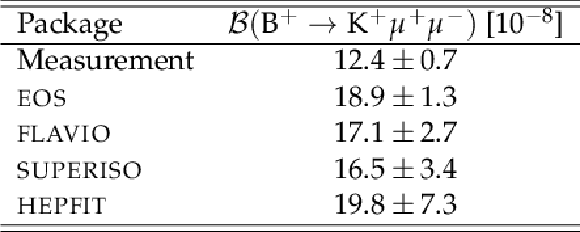
png pdf |
Table 14:
Comparison of the branching fraction B(B+→K+μ+μ−) measurement in the low-q2 bin and the theoretical predictions based on the EOS, FLAVIO, SUPERISO, and HEPFIT packages.. The HEPFIT predictions are only available for q2< 8 GeV2. |

png pdf |
Table 15:
Measurement of the inclusive branching fraction B(B+→K+μ+μ−) using theoretical calculations based on the FLAVIO and SUPERISO packages. The theoretical uncertainty is not included. |
| Summary |
| In summary, we reported the first test of lepton flavor universality in B±→K±ℓ+ℓ− decays, where ℓ is a muon or electron, as well as a measurement of differential and inclusive branching fractions of a nonresonant B±→K±μ+μ− decay with the CMS experiment at the LHC. The analysis was made possible by a dedicated data set of proton-proton collisions at √s= 13 TeV recorded in 2018, using a special high-rate data stream designed for collecting about 10 billion unbiased b hadron decays. The ratio of the branching fractions B(B±→K±μ+μ−) to B(B±→K±e+e−) was measured as a double ratio R(K) of these decays to the respective branching fractions of the B±→J/ψK±(J/ψ→μ+μ−) and (J/ψ→e+e−) decays, which allow for significant cancellation of systematic uncertainties. The ratio R(K) was measured in a range 1.1 <q2< 6.0 GeV2, where q is the invariant mass of the lepton pair, and was found to be R(K)= 0.78 +0.47−0.23, in agreement with the standard model expectation within one standard deviation. This measurement is limited by the statistical precision of the electron channel. The inclusive branching fraction in the same q2 range of B(B±→K±μ+μ−)= ( 12.42 ± 0.54 (stat) ± 0.11 (MC stat) ± 0.40 (syst) ) × 10−8 is consistent with and has a comparable precision to the present world average. This work demonstrates the flexibility of the CMS trigger and its data acquisition system and paves the way to many other studies of a large unbiased sample of b hadron decays collected by CMS at the end of the LHC Run 2. |
| References | ||||
| 1 | S. L. Glashow | Partial Symmetries of Weak Interactions | NP 22 (1961) 579 | |
| 2 | S. Weinberg | A Model of Leptons | PRL 19 (1967) 1264 | |
| 3 | A. Salam | Weak and Electromagnetic Interactions | N. Svartholm (Ed.), Proc. 8-th Nobel Symp., Almquist and Wiksell, 1968 Stockholm 36 (1968) 7 |
|
| 4 | Particle Data Group Collaboration | Review of Particle Physics | PTEP 2022 (2022) 083C01 | |
| 5 | ALEPH, DELPHI, L3, OPAL, LEP Electroweak Collaboration | Electroweak Measurements in Electron-Positron Collisions at W-Boson-Pair Energies at LEP | Phys. Rept. 532 (2013) 119 | 1302.3415 |
| 6 | ATLAS Collaboration | Test of the universality of τ and μ lepton couplings in W-boson decays with the ATLAS detector | Nature Phys. 17 (2021) 813 | 2007.14040 |
| 7 | CMS Collaboration | Precision measurement of the W boson decay branching fractions in proton-proton collisions at √s = 13 TeV | PRD 105 (2022) 072008 | CMS-SMP-18-011 2201.07861 |
| 8 | D. London and J. Matias | B Flavour Anomalies: 2021 Theoretical Status Report | Ann. Rev. Nucl. Part. Sci. 72 (2022) 37 | 2110.13270 |
| 9 | LHCb Collaboration | Test of lepton universality in beauty-quark decays | Nature Phys. 18 (2022) 277 | 2103.11769 |
| 10 | LHCb Collaboration | Test of lepton universality using B+→K+ℓ+ℓ− decays | PRL 113 (2014) 151601 | 1406.6482 |
| 11 | LHCb Collaboration | Test of lepton universality with B0→K∗0ℓ+ℓ− decays | JHEP 08 (2017) 055 | 1705.05802 |
| 12 | LHCb Collaboration | Tests of lepton universality using B0→K0Sℓ+ℓ− and B+→K∗+ℓ+ℓ− decays | PRL 128 (2022) 191802 | 2110.09501 |
| 13 | LHCb Collaboration | Measurement of the isospin asymmetry in B→K(∗)μ+μ− decays | JHEP 07 (2012) 133 | 1205.3422 |
| 14 | LHCb Collaboration | Differential branching fractions and isospin asymmetries of B→K(∗)μ+μ− decays | JHEP 06 (2014) 133 | 1403.8044 |
| 15 | LHCb Collaboration | Measurements of the S-wave fraction in B0→K+π−μ+μ− decays and the B0→K∗(892)0μ+μ− differential branching fraction | [Erratum: \doi10./JHEP04()142], 2016 JHEP 11 (2016) 047 |
1606.04731 |
| 16 | LHCb Collaboration | Branching Fraction Measurements of the Rare B0s→ϕμ+μ− and B0s→f′2(1525)μ+μ−- Decays | PRL 127 (2021) 151801 | 2105.14007 |
| 17 | M. Ciuchini et al. | Charming penguins and lepton universality violation in b→sℓ+ℓ− decays | EPJC 83 (2023) 64 | 2110.10126 |
| 18 | LHCb Collaboration | Test of lepton universality in b→sℓ+ℓ− decays | PRL 131 (2023) 051803 | 2212.09152 |
| 19 | LHCb Collaboration | Measurement of lepton universality parameters in B+→K+ℓ+ℓ− and B0→K∗0ℓ+ℓ− decays | PRD 108 (2023) 032002 | 2212.09153 |
| 20 | M. Bordone, G. Isidori, and A. Pattori | On the Standard Model predictions for RK and RK∗ | EPJC 76 (2016) 440 | 1605.07633 |
| 21 | G. Isidori, S. Nabeebaccus, and R. Zwicky | QED corrections in ¯B→¯Kℓ+ℓ− at the double-differential level | JHEP 12 (2020) 104 | 2009.00929 |
| 22 | G. Isidori, D. Lancierini, S. Nabeebaccus, and R. Zwicky | QED in ¯B→¯K\ensuremath\ell+\ensuremath\ell− LFU ratios: theory versus experiment, a Monte Carlo study | JHEP 10 (2022) 146 | 2205.08635 |
| 23 | CMS Collaboration | Recording and reconstructing 10 billion unbiased b hadron decays in CMS | CMS Detector Performance Summary CMS-DP-2019-043, 2019 CDS |
|
| 24 | CMS Collaboration | CMS luminosity measurements for the 2018 data-taking period at √s= 13 TeV | CMS Physics Analysis Summary, 2018 CMS-PAS-LUM-18-001 |
CMS-PAS-LUM-18-001 |
| 25 | T. Sj\"ostrand et al. | An introduction to PYTHIA 8.2 | Comput. Phys. Commun. 191 (2015) 159 | 1410.3012 |
| 26 | CMS Collaboration | Extraction and validation of a new set of CMS PYTHIA8 tunes from underlying-event measurements | EPJC 80 (2020) 4 | CMS-GEN-17-001 1903.12179 |
| 27 | NNPDF Collaboration | Parton distributions from high-precision collider data | EPJC 77 (2017) 663 | 1706.00428 |
| 28 | D. J. Lange | The EvtGen particle decay simulation package | NIM A 462 (2001) 152 | |
| 29 | E. Barberio and Z. Was | PHOTOS: A Universal Monte Carlo for QED radiative corrections. Version 2.0 | Comput. Phys. Commun. 79 (1994) 291 | |
| 30 | GEANT4 Collaboration | GEANT 4---a simulation toolkit | NIM A 506 (2003) 250 | |
| 31 | CMS Collaboration | Performance of the CMS muon detector and muon reconstruction with proton-proton collisions at √s= 13 TeV | JINST 13 (2018) P06015 | CMS-MUO-16-001 1804.04528 |
| 32 | CMS Collaboration | CMS Tracking Performance Results from Early LHC Operation | EPJC 70 (2010) 1165 | CMS-TRK-10-001 1007.1988 |
| 33 | CMS Collaboration | Particle-flow reconstruction and global event description with the CMS detector | JINST 12 (2017) P10003 | CMS-PRF-14-001 1706.04965 |
| 34 | CMS Collaboration | Electron and photon reconstruction and identification with the CMS experiment at the CERN LHC | JINST 16 (2021) P05014 | CMS-EGM-17-001 2012.06888 |
| 35 | K. Prokofiev and T. Speer | A Kinematic fit and a decay chain reconstruction library | /020, 2004 CMS Note 200 (2004) 4 |
|
| 36 | T. Chen and C. Guestrin | XGBoost: a scalable tree boosting system | 1603.02754 | |
| 37 | M. Pivk and F. R. Le Diberder | SPlot: A Statistical tool to unfold data distributions | NIM A 555 (2005) 356 | physics/0402083 |
| 38 | CMS Collaboration | Measurement of the Inclusive W and Z Production Cross Sections in pp Collisions at √s= 7 TeV | JHEP 10 (2011) 132 | CMS-EWK-10-005 1107.4789 |
| 39 | M. Cacciari, M. Greco, and P. Nason | The P(T) spectrum in heavy flavor hadroproduction | JHEP 05 (1998) 007 | hep-ph/9803400 |
| 40 | M. Cacciari, S. Frixione, and P. Nason | The p(T) spectrum in heavy flavor photoproduction | JHEP 03 (2001) 006 | hep-ph/0102134 |
| 41 | M. Cacciari et al. | Theoretical predictions for charm and bottom production at the LHC | JHEP 10 (2012) 137 | 1205.6344 |
| 42 | M. Cacciari, M. L. Mangano, and P. Nason | Gluon PDF constraints from the ratio of forward heavy-quark production at the LHC at √S= 7 and 13 TeV | EPJC 75 (2015) 610 | 1507.06197 |
| 43 | M. J. Oreglia | A study of the reactions ψ′→γγψ | PhD thesis, Stanford University, . SLAC Report SLAC-R-236, 1980 link |
|
| 44 | J. E. Gaiser | Charmonium spectroscopy from radiative decays of J/ψ and ψ′ | PhD thesis, Stanford University, . SLAC Report SLAC-R-255, 1982 link |
|
| 45 | K. S. Cranmer | Kernel estimation in high-energy physics | Comput. Phys. Commun. 136 (2001) 198 | hep-ex/0011057 |
| 46 | CMS Collaboration | Measurement of the inelastic proton-proton cross section at √s= 13 TeV | JHEP 07 (2018) 161 | CMS-FSQ-15-005 1802.02613 |
| 47 | EOS Authors Collaboration | EOS: a software for flavor physics phenomenology | EPJC 82 (2022) 569 | 2111.15428 |
| 48 | N. Gubernari, M. Reboud, D. van Dyk, and J. Virto | Improved theory predictions and global analysis of exclusive b→sμ+μ− processes | JHEP 09 (2022) 133 | 2206.03797 |
| 49 | D. M. Straub | flavio: a Python package for flavour and precision phenomenology in the Standard Model and beyond | 1810.08132 | |
| 50 | F. Mahmoudi | SuperIso: A Program for calculating the isospin asymmetry of B ---\ensuremath> K* gamma in the MSSM | Comput. Phys. Commun. 178 (2008) 745 | 0710.2067 |
| 51 | F. Mahmoudi | SuperIso v2.3: A Program for calculating flavor physics observables in Supersymmetry | Comput. Phys. Commun. 180 (2009) 1579 | 0808.3144 |
| 52 | J. De Blas et al. | HEPfit: a code for the combination of indirect and direct constraints on high energy physics models | EPJC 80 (2020) 456 | 1910.14012 |
| 53 | L. Alasfar et al. | B anomalies under the lens of electroweak precision | JHEP 12 (2020) 016 | 2007.04400 |
| 54 | M. Ciuchini et al. | Constraints on lepton universality violation from rare B decays | PRD 107 (2023) 055036 | 2212.10516 |
| 55 | N. Gubernari, M. Reboud, D. van Dyk, and J. Virto | Dispersive Analysis of B→K(∗) and Bs→ϕ Form Factors | 2305.06301 | |
| 56 | LHCb Collaboration | Measurement of the phase difference between short- and long-distance amplitudes in the B+→K+μ+μ− decay | EPJC 77 (2017) 161 | 1612.06764 |

|
Compact Muon Solenoid LHC, CERN |

|

|

|

|

|

|